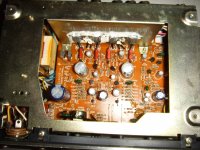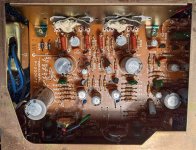Let me preface by saying that I know very little about amplifiers. The diodes (VD1121) between the transistors in the Realistic SA-102 (circa 1980) appear to be coated with silicone. See images here, and also attached. Is this an attempt at thermally coupling them to the transistors?
Attachments
Hi . Are you sure this is silicone? Normally thermal grease is used in these places , to increase thermal conductivity between transistor and insulator ,insulator and heatsink, or other components and heatsink . Air space and non ideal surface create thermal loss ,and grease fill those gaps.
If those diodes are not designed to be mount to heatsink , silicone may be used to fix their position touching heatsink , to sense its temperature ,but i have not seen that yet .
If those diodes are not designed to be mount to heatsink , silicone may be used to fix their position touching heatsink , to sense its temperature ,but i have not seen that yet .
In fact, I have looked inside what I believe is an original SA-102 (?) and it is a rubbery silicone-like material on the diode. Maybe it is a special metalized silicone. If this is some temperature coupling method it seems very crude.
That whole area is swimming in silicone grease, but even if the thermal sensing diode were glued to heatsink with silicone rubber, it´s better thn nothing,definitely better than air.
FWIW I glue/epoxy my sensor diodes or transistors to heatsinks for that very reason.
Even "not too good" paste/adhesive is acceptable here, think of the thermal circuit.
A high value resistor is bad when you must continuously conduct a lot heat from A to B, say from power transistor to heatsink, and then to ambient air, but if from heatsink to sensing junction and then "nowhere else", then said junction will quickly reach heatsink temperature and stay there.
FWIW I glue/epoxy my sensor diodes or transistors to heatsinks for that very reason.
Even "not too good" paste/adhesive is acceptable here, think of the thermal circuit.
A high value resistor is bad when you must continuously conduct a lot heat from A to B, say from power transistor to heatsink, and then to ambient air, but if from heatsink to sensing junction and then "nowhere else", then said junction will quickly reach heatsink temperature and stay there.
It is silicon I have worked on many oe units, and they are all covered in silicon. It's the only thing holding it in place.
Those diodes might be the infamous suicide diodes (V-fet amps 5650/4650 by Sony).
To be replaced with proper dualdiodes, fixed and thermal coupled as appropiate (-> reference #6).
To be replaced with proper dualdiodes, fixed and thermal coupled as appropiate (-> reference #6).
- Home
- Amplifiers
- Solid State
- Diode coating in Realistic SA-102

